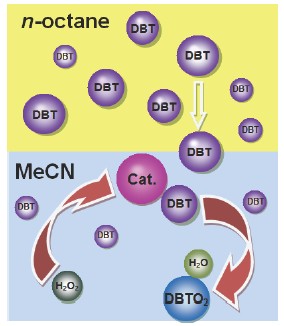| [1] Zannikos, F.; Lois, E.; Stournas, S. Fuel Process. Technol. 1995, 42, 35. [2] Shiraishi, Y.; Taehibana, K.; Hirai, T.; Komasawa, I. Ind. Eng. Chem. Res. 2002, 41, 4362. [3] Lü, F.-Z.; Zhan, F.-T.; Wang, P.; Yao, X.-B. Chem. Eng. Oil Gas 2006, 35, 114. (吕志凤, 战风涛, 王萍, 姚绪波, 石油与天然气化工, 2006, 35, 114.)[4] Otsuki, S.; Nonaka, T.; Takashima, N. Energy Fuels 2000, 14, 1232. [5] Murata, S.; Murata, K.; Kidena, K. Energy Fuels 2004, 18, 116. [6] Zhou, X.; Li, J.; Wang, X.; Jin, K.; Ma, W. Fuel Process. Technol. 2009, 90, 317. [7] Ma, X. L.; Zhou, A. N.; Song, C. S. Catal. Today 2007, 123, 276. [8] Wang, B.; Zhou, J. P.; Ma, H. Z. J. Hazard. Mater. 2009, 164, 256. [9] Wang, D.; Qian, E. W.; Amano, H.; Okata, K.; Ishihara, A.; Kabe, T. Appl. Catal. A: Gen. 2003, 253, 91. [10] Stanger, K. J.; Angelici, R. J. Energy Fuels 2006, 20, 1757. [11] Tang, X.-D.; Shui, L.-L.; Liu, L. Chin J. Catal. 2004, 25, 789. (唐晓东, 税蕾蕾, 刘亮, 催化学报, 2004, 25, 789.)[12] Yazu, K.; Yamamoto, Y.; Furuya, T.; Miki, K.; Ukegawa, K. Energy Fuels 2001, 15, 1535. [13] Zannikos, F.; Lois, E.; Stoumas, S. Fuel Process. Technol. 1995, 42, 35. [14] Bonde, S. E.; Gore, W.; Dolbear, G. E.; Skov, E. R. Am. Chem. Soc., Div. Petrol. Chem. Prepr. 2000, 45, 364. [15] Filippis, P. D.; Scarsella, M. Energy Fuels 2003, 17, 1452. [16] Yu, G. X.; Lu, S. X.; Chen, H.; Zhu, Z. N. Energy Fuels 2005, 19, 447. [17] Yu, G. X.; Lu, S. X.; Chen, H.; Zhu, Z. N. Carbon 2005, 43, 2285. [18] Te, M.; Fairlbridge, C.; Ring, Z. Appl. Catal. A: Gen. 2001, 219, 267. [19] Collins, F. M.; Lucy, A. R.; Sharp, C. J. Mol. Catal. A: Chem. 1997, 117, 397. [20] Yazu, K.; Yamamoto, Y.; Furuya, T.; Miki, K.; Ukegawa, K. Energy Fuels 2001, 15, 1535. [21] Yazu, K.; Furuya, T.; Miki, K.; Ukegawa, K. Chem. Lett. 2003, 32, 920. [22] Trakarnpruk, W.; Rujiraworawut, K. Fuel Process. Technol. 2009, 90, 411. [23] Wang, R.; Zhang, G. F.; Zhao, H. X. Catal. Today 2010, 149, 117. [24] Zhang, M.; Zhu, W. S.; Xun, S. H.; Li, H. M.; Gu, Q. Q.; Zhao, Z.; Wang, Q. Chem. Eng. J. 2013, 220, 328. [25] Wang, E. B.; Hu, C. W.; Xu, L. Introduction to Polyoxometalate Chemistry, Chemical Industry Press, Beijing, 1998, pp. 15~16. (王恩波, 胡长文, 许林, 多酸化学导论, 化学工业出版社, 北京, 1998, pp. 15~16.)[26] Xi, Z. W.; Zhou, N.; Sun, Y.; Li, K. L. Science 2001, 292, 1139. [27] Zhou, N.; Xi, Z.-W.; Cao, G.-Y.; Fan, S.-H. J. Mol. Catal. 2001, 15, 113. (周宁, 奚祖威, 曹国英, 范淑华, 分子催化, 2001, 15, 113.)[28] Sun, Y.; Xi, Z. W.; Cao, G. Y. J. Mol. Catal. A: Chem. 2001, 166, 219. [29] Zhou, N.; Xi, Z. W.; Cao, G. Y.; Gao, S. Appl. Catal. A: Gen. 2003, 250, 239. [30] Salles, L.; Aubry, C.; Thouvenot, R.; Robert, F.; Doremieux-Morin, C.; Chottard, G.; Ledon, H.; Jeannin, Y.; Brégeault, J. M. Inorg. Chem. 1994, 33, 871. [31] Salles, L.; Aubry, C.; Robert, F.; Chottard, G.; Thouvenot, R.; Ledon, H.; Brégeault, J. M. New J. Chem. 1993, 17, 367. [32] Cavani, F. Catal. Today 1998, 41, 73. [33] Zhang, G. F.; Wang, R.; Yu, F. L.; Zhao, H. X. Chem. Pap. 2009, 63, 617. [34] Zhang, B. Y.; Jiang, Z. X.; Li, J.; Zhang, Y. N.; Lin, F.; Liu, Y.; Li, C. J. Catal. 2012, 287, 5. [35] Chen, L. J.; Guo, S. H.; Zhao, D. S. Chinese J. Chem. Eng. 2006, 14, 835. [36] Wang, R.; Yu, F. L.; Zhang, G. F.; Zhao, H. X. Catal. Today 2010, 150, 37. [37] Li, F.-T.; Kou, C.-G.; Sun, Z.-M.; Hao, Y.-J.; Liu, R.-H.; Zhao, D.-S. J. Hazard. Mater. 2012, 205-206, 164. [38] Zhang, M.; Zhu, W. S.; Xun, S. H.; Li, H. M.; Gu, Q. Q.; Zhao, Z.; Wang, Q. Chem. Eng. J. 2013, 220, 328. [39] Zhu, W. S.; Huang, W. L.; Li, H. M.; Zhang, M.; Jiang, W.; Chen, G. Y.; Han, C. R. Fuel Process. Technol. 2011, 92, 1842. |
